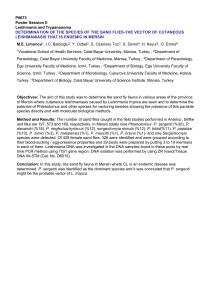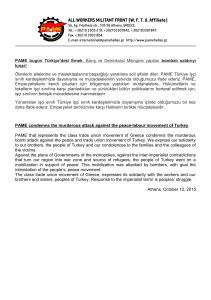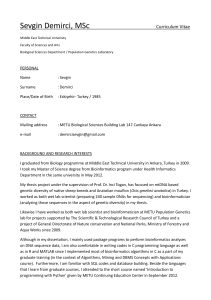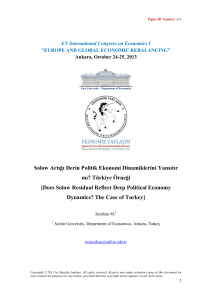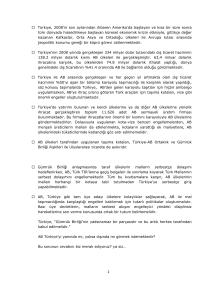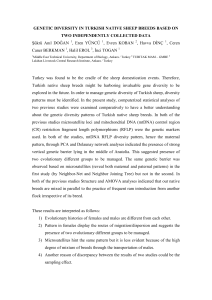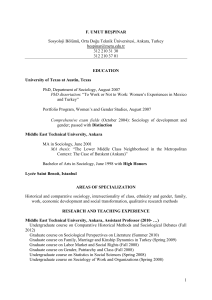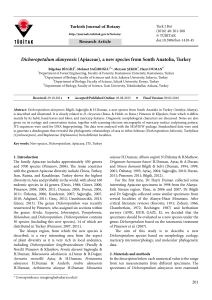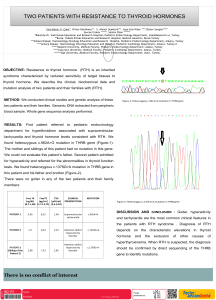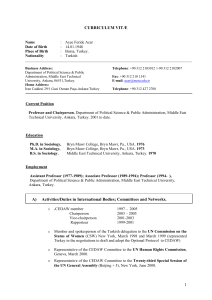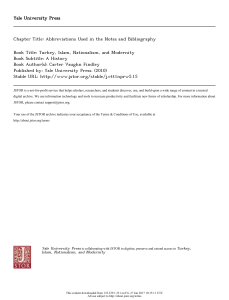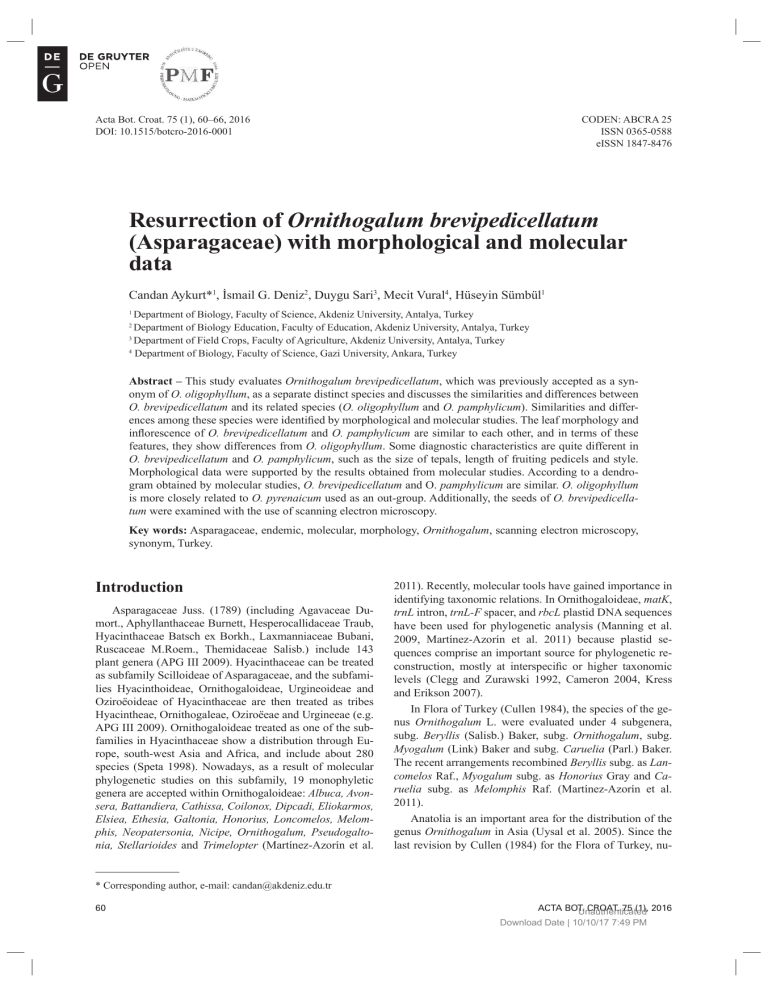
Acta Bot. Croat. 75 (1), 60–66, 2016
DOI: 10.1515/botcro-2016-0001
CODEN: ABCRA 25
ISSN 0365-0588
eISSN 1847-8476
Resurrection of Ornithogalum brevipedicellatum
(Asparagaceae) with morphological and molecular
data
Candan Aykurt*1, İsmail G. Deniz2, Duygu Sari3, Mecit Vural4, Hüseyin Sümbül1
Department of Biology, Faculty of Science, Akdeniz University, Antalya, Turkey
Department of Biology Education, Faculty of Education, Akdeniz University, Antalya, Turkey
3
Department of Field Crops, Faculty of Agriculture, Akdeniz University, Antalya, Turkey
4
Department of Biology, Faculty of Science, Gazi University, Ankara, Turkey
1
2
Abstract – This study evaluates Ornithogalum brevipedicellatum, which was previously accepted as a synonym of O. oligophyllum, as a separate distinct species and discusses the similarities and differences between
O. brevipedicellatum and its related species (O. oligophyllum and O. pamphylicum). Similarities and differences among these species were identified by morphological and molecular studies. The leaf morphology and
inflorescence of O. brevipedicellatum and O. pamphylicum are similar to each other, and in terms of these
features, they show differences from O. oligophyllum. Some diagnostic characteristics are quite different in
O. brevipedicellatum and O. pamphylicum, such as the size of tepals, length of fruiting pedicels and style.
Morphological data were supported by the results obtained from molecular studies. According to a dendrogram obtained by molecular studies, O. brevipedicellatum and O. pamphylicum are similar. O. oligophyllum
is more closely related to O. pyrenaicum used as an out-group. Additionally, the seeds of O. brevipedicellatum were examined with the use of scanning electron microscopy.
Key words: Asparagaceae, endemic, molecular, morphology, Ornithogalum, scanning electron microscopy,
synonym, Turkey.
Introduction
Asparagaceae Juss. (1789) (including Agavaceae Dumort., Aphyllanthaceae Burnett, Hesperocallidaceae Traub,
Hyacinthaceae Batsch ex Borkh., Laxmanniaceae Bubani,
Ruscaceae M.Roem., Themidaceae Salisb.) include 143
plant genera (APG III 2009). Hyacinthaceae can be treated
as subfamily Scilloideae of Asparagaceae, and the subfamilies Hyacinthoideae, Ornithogaloideae, Urgineoideae and
Oziroëoideae of Hyacinthaceae are then treated as tribes
Hyacintheae, Ornithogaleae, Oziroëeae and Urgineeae (e.g.
APG III 2009). Ornithogaloideae treated as one of the subfamilies in Hyacinthaceae show a distribution through Europe, south-west Asia and Africa, and include about 280
species (Speta 1998). Nowadays, as a result of molecular
phylogenetic studies on this subfamily, 19 monophyletic
genera are accepted within Ornithogaloideae: Albuca, Avonsera, Battandiera, Cathissa, Coilonox, Dipcadi, Eliokarmos,
Elsiea, Ethesia, Galtonia, Honorius, Loncomelos, Melomphis, Neopatersonia, Nicipe, Ornithogalum, Pseudogaltonia, Stellarioides and Trimelopter (Martínez-Azorín et al.
2011). Recently, molecular tools have gained importance in
identifying taxonomic relations. In Ornithogaloideae, matK,
trnL intron, trnL-F spacer, and rbcL plastid DNA sequences
have been used for phylogenetic analysis (Manning et al.
2009, Martínez-Azorín et al. 2011) because plastid sequences comprise an important source for phylogenetic reconstruction, mostly at interspecific or higher taxonomic
levels (Clegg and Zurawski 1992, Cameron 2004, Kress
and Erikson 2007).
In Flora of Turkey (Cullen 1984), the species of the genus Ornithogalum L. were evaluated under 4 subgenera,
subg. Beryllis (Salisb.) Baker, subg. Ornithogalum, subg.
Myogalum (Link) Baker and subg. Caruelia (Parl.) Baker.
The recent arrangements recombined Beryllis subg. as Lancomelos Raf., Myogalum subg. as Honorius Gray and Caruelia subg. as Melomphis Raf. (Martínez-Azorín et al.
2011).
Anatolia is an important area for the distribution of the
genus Ornithogalum in Asia (Uysal et al. 2005). Since the
last revision by Cullen (1984) for the Flora of Turkey, nu-
* Corresponding author, e-mail: candan@akdeniz.edu.tr
60
ACTA BOT.
CROAT. 75 (1), 2016
Unauthenticated
Download Date | 10/10/17 7:49 PM
TAXONOMIC NOTES ON ORNITHOGALUM BREVIPEDICELLATUM
merous new taxa, records and combinations of Ornithogalum have been introduced from Turkey (e.g. Davis et al.
1988, Özhatay 2000, Düşen and Sümbül 2002, 2003, Düşen
and Deniz 2005, Uysal et al. 2005, Özhatay and Kültür
2006, Bağcı et al. 2009, 2011, Özhatay et al. 2009, Yıldırımlı 2009, Koca and Yıldırımlı 2010, Özhatay et al. 2011,
Mutlu and Karakuş 2012). A total of 61 species of the genus
Ornithogalum are distributed in Turkey, 31 of them endemic to the country (Uysal 2012).
The first specimens of Ornithogalum brevipedicellatum
in Turkey were collected by Bourgeau in 1860 in the higher
mountain steppes of the Elmalı (Antalya) district, the region known as ‘Lycia’ in antiquity. These specimens were
evaluated under the name of “O. brevipedicellatum” by
Boissier, and subsequently were introduced to science in
1873 by Baker (Boissier 1884, Cullen 1984). O. brevipedicellatum was reported as the synonym of the O. oligophyllum species in the Flora of Turkey (Cullen 1984), the Plant
List of Turkey (Uysal 2012) and in “The Plant List” database. O. oligophyllum has a substantially wide area of occupancy in Turkey. It was previously reported in The Flora
of Turkey that the specimens of the species O. oligophyllum, which were collected in Antalya, Isparta and Konya,
would be classified as O. brevipedicellatum provided that
the distinguishing determinant characteristics were supported by a sufficient number of samples (Cullen 1984).
Materials and methods
Plant samples and morphological studies
The plant specimens of the genus Ornithogalum were
collected by field studies between 2012 and 2014 in the
Muğla and Antalya Provinces. During the field studies,
GPS locations of O. brevipedicellatum were taken, and the
individuals of its populations were numbered. This data
was used to determine the threat category of O. brevipedicellatum according to the Categories and criteria of IUCN
(Version 11, 2014). The extent of occurrence (EOO) and
area of occupancy (AOO) values were calculated.
In the present study, Ornithogalum brevipedicellatum
known as a synonym of O. oligophyllum is morphologically described in detail and compared with its related species,
O. oligophyllum and O. pamphylicum O.D.Düşen & Sümbül, with the data obtained from morphological and molecular studies. The individuals of these species were observed
during field studies and the morphological evaluations were
done both in the field and in laboratory. Specimens collected and used in molecular studies within the scope of this
study, are shown in Tab. 1. The digital isotype photographs
obtained from MNHN (Museum National d’Histoire Naturelle) of O. brevipedicellatum were also examined. Additionally, a number of herbarium specimens of O. oligophyllum collected from different parts of Turkey in the ISTE
(Istanbul University, Herbarium of the Faculty of Pharmacy) and GAZI (Gazi University Herbarium) were morphologically examined (see Appendix).
Seed micromorphology of Ornithogalum brevipedicellatum was investigated using scanning electron microscopy
(SEM) techniques. For SEM study, the seeds were treated
with gold conjugate on stub. The microphotographs were
taken with a Zeiss LEO-1430 scanning electron microscope.
Molecular study: DNA isolation, PCR amplification and
sequencing
Complete DNA of Ornithogalum brevipedicellatum and
O. pamphylicum was extracted from the leaves of herbarium specimens using the cetyl trimethyl ammonium bromide (CTAB) method of Doyle and Doyle (1990). DNA
concentration and quality were tested with 1% agarose gel
against a DNA standard. Two different plastid regions were
used for molecular analysis to identify the phylogenetic
similarities of the species. Amplification of these regions
was conducted with the universal primers used in previous
Tab. 1. Locality data of collected specimens of Ornithogalum for the current study.
Species
Locality
Collection data
O.
brevipedicellatum
C2 Muğla, Fethiye, Seki, 6 km from Seki to Yuva, Ak Mountain, steppe, 1980 m, 27.iv.2012.
C. Aykurt 3071(AKDU)
Muğla, Fethiye, Seki, 4–6 km from Seki to Yuva, Ak Mountain, 1900–1980 m, steppe, 4.v.2012.
C. Aykurt 3084 (AKDU)
Muğla: Fethiye, Seki, 4–6 km from Seki to Yuva, Ak Mountain, 1900–1980 m, steppe, 22.v.2012.
C. Aykurt 3137* (AKDU)
Antalya: Kaş, Gömbe, between Gömbe-İkizgöller, Subaşı environs, plateau, 2080 m, 25.05.2012.
C. Aykurt 3156 (AKDU)
Muğla, Fethiye, Seki, 6 km from Seki to Yuva, Ak Mountain, steppe, 1975 m, 30.04.2013.
C. Aykurt 3741* (AKDU)
Muğla, Fethiye, Seki, 6 km from Seki to Yuva, Ak Mountain, steppe, 1827 m, 30.04.2013.
C. Aykurt 3742* (AKDU)
Muğla, Fethiye, Seki, 6 km from Seki to Yuva, Ak Mountain, steppe, 1825 m, 23.05.2013.
C. Aykurt 3868 (AKDU)
Muğla, Fethiye, Seki, 6 km from Seki to Yuva, Ak Mountain, steppe, 1975 m, 23.05.2013.
C. Aykurt 3869 (AKDU)
Antalya, above Fesleğen Plateau, Sakarpınar, 1850–1900 m, calcerous slopes, 4.v.2012.
C. Aykurt 3087 (AKDU)
Antalya, Elmalı, İmecik Plateau, Bey Mountains, 1800 m, 29.04.2012.
C. Aykurt 3089* (AKDU)
Antalya, Elmalı, Kızlarsivrisi Mountain, Karakuyu district, 1900 m, openings in Cedrus libani
forest, calcareous slopes, 09.v.2012.
İ.G. Deniz 4528 (AKDU)
Antalya: Çalbalı Mountain, 1700 m, calcareous slopes, 15.v.2014.
İ.G. Deniz 5548 (AKDU)
C3 Antalya: Sarıçınar, 36 S 274566, 4096808, 1380 m, 14.iv.2014.
C. Aykurt 3882 (AKDU)
C2 Antalya: Finike, West side of Finike, under Cedrus libani, 1200 m, 24.iv.2014.
C. Aykurt 3911 (AKDU)
O.
pamphylicum
O. oligophyllum
ACTA BOT. CROAT. 75 (1), 2016
Unauthenticated
Download Date | 10/10/17 7:49 PM
61
AYKURT C., DENIZ I. G., SARI D., VURAL M., SÜMBÜL H.
studies. The trnL intron and trnL spacers were amplified
with c (5’-CGAAATCGGTAGACGCTACG) and f (5’-ATTTGAACTG-GTGACACGAG) primers described in Taberlet
et al. (1991). Amplification of the rbcL gene was performed
using a forward primer (427F), 5’-GCTTATTCAAAAACTTTCCAAGGCCCGCC, and a reverse primer (724R),
5’-TCGCATGTACCTGCAGTTGC (Lledó et al. 1998).
Polymerase chain reaction (PCR) for both trnL and rbcL
regions contained 2 mM MgCl2, 0.2 mM of each dNTP, 10
pM μL–1 of each primer, 1 U of Taq DNA polymerase (Fermentas Life Sciences, Burlington, Canada) with supplied
reaction buffer at 10× concentration, and 40 ng of template
DNA. The amplifications were performed on a programmable thermocycler (BIONEER, MyGenie™) with the following program: one cycle of 4 min at 94 °C, 28 cycles of 1
min at 94 ºC, 30 s at 48 °C for rbcL, or 1 min at 50 °C for
trnL, 1 min at 72 °C, and for final extension one cycle of 7
min at 72 °C. PCR products were cleaned up using the
GeneJET gel extraction kit (Thermo Scientific Fermentas,
Vilnius, Lithuania). Sequencing process was carried out at
Iontek Laboratory in Istanbul, Turkey as direct sequencing
from PCR products. The sequences of other species (O. oligophyllum and O. pyrenaicum) were retrieved from GenBank databases at the National Center for Biotechnology
Information (NCBI) and compared with O. brevipedicellatum trnL and rbcL sequences. A phylogenetic tree was
constructed using the software MEGA 5. Bootstrap values
are displayed at tree nodes (Tamura et al. 2011).
Results
Morphological studies
Ornithogalum brevipedicellatum Boiss. ex Baker, J. Linn.
Soc., Bot. 13: 263 (1873) (Figs. 1–3)
Geophyte, 5–10(–15) cm high; bulb 1.3–1.8(–2) × 1.3–
1.8(–2) cm, ovoid-spherical, without bulblets; outer tunics
cream to pale-brown. Leaf synanthous, 4–6(–7), 9–37 ×
2.3–0.5 cm, linear-lanceolate, canaliculate, with a whitish
median line, gradually narrowing towards the base, longer
than scape, margins entire, glabrous. Scape below the
ground level, 3–12 cm, slender. Inflorescence congested
racemose, racem borne at ground level, dense, 2–6 × 3–4.5
cm, erect, with (1–)5–15(–18) flowers. Bracts lanceolate,
long acuminate, (12–)15–23 × 3–5 mm, membranous, longer than pedicels. Flowers sessile or subpedicellate up to 3
mm at anthesis and fruiting period. Tepals eliptic to ovateeliptic, obtuse to acute at apex; outers 12–18 × 4–5 mm;
inners 13–18 × 4.5–5 mm, white inside, green with narrowly white margins outside. Filaments white, conspicuously
tapering towards the apex, 4–6 × 1–2 mm; anthers medifixed,
milky white, 2–2.2 mm length. Ovary ovoid, 3.5–5 × 2–3.5
mm, pale green, longer than style; style 1.5–2 mm length;
stigma capitate. Capsule 10–15 × 10–15 mm, ovoid, erect,
distinctly winged, pale brown. Seeds numerous, 1.8–2 ×
1.2–1.8 mm, elliptic-subglobose to globose, black, strongly
apiculate; testa reticulate, with reticules formed by prominent crests, testa cells irregular.
Hitherto Ornithogalum brevipedicellatum was evaluated as the synonym of O. oligophyllum; however the species
62
Fig. 1. Ornithogalum brevipedicellatum (from C. Aykurt 3071): a)
habit, b): flower, c) stamen, d) pistil, e) capsule. Scale bars: 1 cm
(a,b,e), and 1 mm (c,d).
Fig. 2. SEM photographs of the seeds of Ornithogalum brevipedicellatum (from C. Aykurt 3137): a) seed, b) seed surface.
is morphologically more related to O. pamphylicum, described in 2002. The inflorescence type of O. brevipedicellatum is similar to O. pamphylicum. The raceme of O. brevipedicellatum is very condensed in flowering and fruiting
period and borne at ground level. Its flowers are sessile or
the floral or fruiting pedicels are up to 3 mm long. The inflorescence of O. pamphylicum resembles O. brevipedicellatum, but the internodes are more elongated and the pedicels are flaccid and longer at fruiting time. On the other
hand, the lower pedicels of O. oligophyllum are longer then
the flowers; fruiting pedicels are 10–30 mm long. Therefore, the inflorescence of O. oligophyllum can be evaluated
as corymbose or pseudocorymbose. Moreover, the inflorescence of O. brevipedicellatum is different due to its sessile
or subpedicellate flowers.
ACTA BOT.
CROAT. 75 (1), 2016
Unauthenticated
Download Date | 10/10/17 7:49 PM
TAXONOMIC NOTES ON ORNITHOGALUM BREVIPEDICELLATUM
Fig. 3. Ornithogalum brevipedicellatum on Ak Mountain (Elmalı,
Antalya).
The other morphological differences of O. brevipedicellatum, O. oligophyllum and O. pamphylicum are shown in
Tab. 2.
sion 11), the species should be placed in the EN (endangered) category, according to the criteria for critically endangered, endangered and vulnerable.
The subpopulations of the species were identified in
Seki (Muğla) and Gömbe (Kas, Antalya) (Fig. 4). No artificial factors endangering the development of the species in
its area of occupancy were present. Therefore, it was projected that the population of the species in terms of percentage did not decrease through time as a result of anthropological effects. Item A cannot therefore be evaluated. The
distance between the two locations of the species is 25 km.
The EOO value of the species was determined as 130 km2
(EN B1b(iii)) taking both locations of occupancy and the
area contained within the shortest continuous imaginary
boundary. The AOO value in this area, where the species
was identified was calculated as 13 km2 (EN B2b(ii)). The
number of individuals identified in the subpopulations of
the species was determined as 400 at the Seki location and
200 at the Gömbe location (EN C).
Habitat, distribution and conservation status
Ornithogalum brevipedicellatum shares its habitats with
several herbaceous plants such as Cerastium macranthum
Boiss. Ceratocephala falcata (L.) Pers., Corydalis erdelii
Zucc., Crocus biflorus Mill. subsp. isauricus (Siehe ex
Bowles) B. Mathew, Fumaria asepala Boiss., Gagea villosa (M. Bieb.) Sweet subsp. hermonis Dafni & Heyn, Scilla
bifolia L., Tussilago farfara L., Viola heldreichiana Boiss.
An old specimen collection record was documented in
Flora Orientalis indicating that specimens of the Ornithogalum brevipedicellatum species were collected on Mount
Trodos in southern Cyprus (Boissier 1884). However, recent data supporting these dubious records was not documented and for that reason, the species O. brevipedicellatum was evaluated as endemic to Turkey.
The conservation status of Ornithogalum brevipedicellatum is described below according to the rules of citation.
Considering the IUCN (2014) categories and criteria (Ver-
Fig. 4. Distribution areas of Ornithogalum brevipedicellatum (),
Ornithogalum oligophyllum (●) and Ornithogalum pamphylicum
(◼) in Turkey.
Molecular studies
Individuals of Ornithogalum brevipedicellatum and O.
pamphylicum were collected from different localities for
molecular analysis (Tab. 1). The sequences of these specimens were compared and evaluated with O. oligoliphylum
Tab. 2. Comparison of the morphological characters of Ornithogalum brevipedicellatum, O. oligophyllum and O. pamphylicum.
Features
O. brevipedicellatum
O. oligophyllum
O. pamphylicum
Scape length (cm)
3–12 (borne at ground level)
4–15
3–15
Number of leaves
4–6(–7)
2–3 (rarely 4)
(3–)4–11(–13)
Leaves
with a whitish median line
without a whitish median line
with a whitish median line
Leaves width
2–5 mm
5–20 mm
1–4 mm
Inflorescence
congested racemose
corymbose or
pseudocorymbose
laxly racemose
(internodes more elongated)
(1–)5–15(–18)
3–10(–20)
3–25
Capsules sessile or
subpedicellate (up to 3 mm
long), erect
10–30 mm,
become flaccid at base
Capsules pedicettale
(6–12 mm), erect
odour
odourless
odourless
12–18 × 4–5
–
20–30 × 5–9
1.5–2
2–3.5
4–5
Number of flowers
Fruiting pedicels
Flowers
Tepals (mm)
Style length (mm)
ACTA BOT. CROAT. 75 (1), 2016
Unauthenticated
Download Date | 10/10/17 7:49 PM
63
AYKURT C., DENIZ I. G., SARI D., VURAL M., SÜMBÜL H.
Fig. 5. Phylogenetic trees of trnL (a) and rbcL (b) sequences from six Ornithogalum specimens. Locations (*) and GenBank accession
numbers (**) are given next to the Ornithogalum name.
and O. pyrenaicum retrieved from the GenBank database.
To amplify the trnL and rbcL region of O. brevipedicellatum and O. pamphylicum species, c/f and 427F/724R primer pairs were used, respectively, as described in methodology section. About 1200 bp amplicons for trnL and 300 bp
amplicons for rbcL were yielded in PCR assays. These amplicons were sequenced and compared with those of O. oligophyllum species (Fig. 5) available in the GenBank using
the BLAST similarity search tool. In the trnL tree, two
groups were identified. All of the individuals of O. brevipedicellatum were aligned in the first group. O. pamphylicum was the closest species to O. brevipedicellatum while
O. oligophyllum and O. pyrenaicum were more distant from
this group. Similarly, three individuals of O. brevipedicellatum were located together in the rbcL tree. Although O.
pamphylicum was placed in a different branch, it was the
closest species to O. brevipedicellatum while O. oligophyllum and O. pyrenaicum species were positioned in another
group.
Discussion
The Ornithogalum genus, previously classified into numerous subcategories by several different researchers, was
rearranged recently in the light of the novel molecular phylogenetic studies conducted on the Ornithogaloideae subfamily (Martínez-Azorín et al. 2011). Moret and Galland
(1992) indicated that many taxa have been described in
subg. Ornithogalum which is a taxonomically problematic
subgenus on the basis of subtle morphological variations,
usually with little biological significance. The complex taxonomy of subg. Ornithogalum may be due to intraspecific
variations, the plasticity of individuals, their habits being
strongly dependent on environmental factors and poor conservation of the types (Moret and Galland 1992).
Martínez-Azorín et al. (2010) reported that some authors have used the inflorescence structure and/or the length
of the floral bracts relative to their pedicels as diagnostic
characteristics. When Ornithogalum brevipedicellatum, O.
64
pamphylicum and O. oligohyllum species are evaluated
with respect to the inflorescence type and length of the pedicels, it is seen that the specimens of O. brevipedicellatum
are distinct; distinguished from the other species by the lack
of pedicels, or the presence of very short pedicels- either
during flowering or fruiting periods. The presence of very
short internodes between the flowers in the subpedicellate
or the sessile flowers allowed the inflorescence of the species to be evaluated as congested racemose, rather than corymb or pseudocorymb. Furthermore, the habitus of these
three species show differences, while the first flowers of O.
brevipedicellatum and O. pamphylicum are at ground level
but the inflorescence of O. oligophyllum has generally a
scape above ground level. The pedicels of O. oligophyllum
are distinctly longer than the pedicels of O. brevipedicellatum and O. pamphylicum in flowering and fruiting periods.
Ornithogalum brevipedicellatum and O. pamphylicum
are similar to each other with respect to their leaf morphology and inflorescence in flowering time. They have narrower leaves from O. oligophyllum. We observed the white
line on the leaf surface of O. pamphylicum and the ovary of
the species is distinctly winged, contrary to the description
of the species by Düşen and Sümbül (2002). Therefore, O.
pamphylicum was included in subg. Ornithogalum in the
present study but, on the contrary, in subg. Myogalum by
Düşen and Sümbül (2002). The closer morphologic proximity between O. brevipedicellatum and O. pamphylicum
as opposed to O. oligophyllum was supported by the data
obtained from molecular studies. Considering to the phylogenetic tree obtained from trnL and rbcL sequences, the individuals of O. brevipedicellatum were separated from O.
oligophyllum in two different dendograms. O. brevipedicellatum are closer to O. pamphylicum compared with O. oligophyllum.
The most remarkable morphological differences between O.brevipedicellatum and O. pamphylicum can be defined as follows: (1) The capsules of O. brevipedicellatum
are generally sessile, sometimes subpedicellate but they are
pedicellate and pendant in O. pamphylicum; (2) lengths of
ACTA BOT.
CROAT. 75 (1), 2016
Unauthenticated
Download Date | 10/10/17 7:49 PM
TAXONOMIC NOTES ON ORNITHOGALUM BREVIPEDICELLATUM
the style are quite different; (3) O. brevipedicellatum has
more congested inflorescence while the internodes are elongated in O. pamphylicum; (4) The tepals are more narrow in
O. brevipedicellatum (Tab. 2).
The seed size, shape, color, surface ornamentation and
shape of the cells, raphe, micropylar and chalazal poles are
useful diagnostic characteristics for seed micro-morphological studies conducted on the genus Ornithogalum (Bednorz and Czarna 2008, Çitak et al. 2015). Moret et al. (1990)
and Martínez-Azorín et al. (2010) reported that subg. Ornithogalum shows globose and apiculate seeds with reticulate
testa. Similarly, the seeds of O. brevipedicellatum are elliptic-subglobose to globose, distinctly apiculate with reticulate testa. The results obtained from the present study clearly indicate that O. brevipedicallatum is a distinct species
and cannot be claimed to be a synonym of O. oligophyllum.
Acknowledgements
The authors are indebted to Akdeniz University Scientific Research Projects Unit (Project number: 2012.01.
0115.004) for financial support to field studies and thanks
to the curators of AKDU, ISTE and GAZI.
Appendix
Additional specimens examined
O. oligophyllum: A1(E) Kırklareli: Demirköy, Mahyadağ, Mareşal road, Fagus gap, 860 m, 22.5.1974, A. Baytop
et E. Tuzlacı (28271 ISTE). Kırklareli: Demirköy, Mahyadağ, 1030 m, 22.5.1974, A. Baytop et E. Tuzlacı (28304
ISTE). Kırklareli: Merkez, between Dereköy and boundary,
1.5.1973, G. Ertem (24281 ISTE). Kırklareli: Centre, woodlands in Dereköy, Kocakaynak environs, 26.4.1974, N.
Özhatay, E. Özhatay (27642 ISTE), Kırklareli: Demirköy,
between Yeniceköy and Velika, 1 km to Haydut Mountain,
24.4.1988, G. Dalgıç, N. Başak (59757 ISTE). Kırklareli:
Centre, Dereköy, boundary, under Fagus, 23.4.1988, G.
Dalgıç, N. Başak (59758 ISTE). Kırklareli: Demirköy, Velika, Balaban village picnic areas, under woodlands,
24.4.1988, G. Dalgıç, N. Başak (59766 ISTE). A3 Bolu:
between Bolu and Mudurnu, under Quercus, 1250–1350 m,
03.05.1993, Z. Aytaç 5789 et al. (GAZI). Bolu: Kale,
Tenekeci River, streamside, woodlands, 800 m, İ. Kılınç
1029 (GAZI). A4 Ankara: Kızılcahamam, Soğuksu National Park, Çakmaklı environs, 1450–1500 m, 12.05.1990, Ö.
Eyüboğlu (GAZI). Ankara: Çubuk, between Ovacık and
References
APG III., Angiosperm Phylogeny Group, 2009: An update of the
angiosperm phylogeny group classification for the orders and
families of flowering plants: APG III. Botanical Journal of the
Linnean Society 161, 105–121.
Bağcı, Y., Savran, A., Başköse, İ., 2009: Ornithogalum nurdaniae
(Liliaceae), a new species from northwest Anatolia, Turkey.
Turkish Journal of Botany 33, 163–167.
Bağcı, Y., Savran, A., Düşen, O. D., Tutar, L., 2011: Ornithogalum
beyazoglui (Hyacinthaceae), a new species from west Anatolia, Turkey. Bangladesh Journal of Plant Taxonomy 18, 51–55.
ACTA BOT. CROAT. 75 (1), 2016
Saraycık villages, Borucağın Hill, shrubs, 1250–1380 m,
20.5.1992, E. Dündar 1193 (GAZI). Çankırı: Atkaracalar,
Dumanlı Mountain, Atkaracalar plateau, Abaza River environs, steppe, 1300–1450, 09.05.1992, A. Duran 1516
(GAZI). Ankara: Ayaş, Ayaşbeli, Çal Hill, steppe, 1300–
1380 m, 13.04.1986, M. Vural 4029 (GAZI). Kırıkkale:
Koçubaba Town, 1200 m, 31.03.1990, A.A. Dönmez 1696
(GAZI). A9 Kars: Arpaçay, Karakale Village, under Rumex
shrubs, 2250 m, 16.06.1984, H. Ocakverdi 1714 (GAZI).
Ardahan: Posof, Baykent village, birch woodlands, 1900 m,
25.6.2007, Sezgin Esen (87083 ISTE). Ardahan: Çataldere
village birch woodlands, 9.6.2008, Sezgin Esen (87275
ISTE). B4 Kırşehir: Çiçek Mountain, Halaçlı Village,
Almanderebaşı environs, Quercus shrubs, slopes, 1550 m,
09.05.1993, F.A. Karavelioğulları 1026 et al. (GAZI). B5
Nevşehir: between Uçhisar and Göreme, erosional dry
slopes, 1250 m, 19.04.1989, M. Vural 4497 et al. (GAZI).
B6 Kayseri: Sarız, Yalak environs, Binboğa Mountain,
steppe, 1800–2200 m, 07.05.1991, Z. Aytaç 3709 et al.
(GAZI). Kahramanmaraş: Binboğa Mountain, west of
Kaşvut Village, alpine steppe, under Cedrus libani, cliffs,
1750–2250 m, 08.05.1991, Z. Aytaç 3733 et al. (GAZI).
Kayseri: Sarız, Binboğa Mountain, Doğankonak, Karagöz,
1450–1900 m, 21.04.1992, Z. Aytaç 4486 et al. (GAZI).
Kayseri: Pınarbaşı, south of Aşağıbeyçayırı village, eroded
west slopes, 29.4.2004, B. Yıldız, T. Arabacı (89931 ISTE).
B7 Malatya: Kubbe Mountain, Kubbe plateau, mountain
steppe, 1700 m, 1.6.1992, B.Yıldız 9378 (ISTE). B8 Erzurum: between Aşkale and Tercan, Kükürtlü environs,
slopes and shrubs, 1950 m, 23.5.2004, M. Koyuncu, M. Fırat, M. Armağan (88864 ISTE). B9 Bitlis: Adilcevaz,
Süphan Mountain hillside, Süte plateau, meadows, 1900 m,
04.06.1993, Y. Altan 4796 (GAZI). Van: Gevaş, west slopes
of Çadır Mountain, steppe, 2300 m, 06.06.1993, Y. Altan
5077 (GAZI). C3 Isparta: Barla, Gelincik Mountain,
Tahtacıçukuru Hills environs, Pinus nigra, 1800–1900 m,
09.05.2009, H. Duman 9921 (GAZI). C6 Kahramanmaraş:
Engizek Mountain, Küçükcerit Village, under Quercus,
1400–1500 m, 21.04.1987, H. Duman 2486 (GAZI).
Kahramanmaraş: Engizek Mountain, south of Şaç Rocks,
wetlands, 2400–2500 m, 20.05.1987, H. Duman 2680
(GAZI). Kahramanmaraş: Erince Mountain, under Quercus, 1300–1400 m, 22.04.1987, H. Duman 2507 (GAZI).
Kahramanmaraş: between Göksun and Geben, Kayranlı
Mountain, east slopes, 30.4.2014, B. Yıldız, T. Arabacı
(89959 ISTE). C7 Şanşıurfa: Karacadağ, 2 km from
Karabahça to Dağ, Reme River environs, stony areas, 1400
m, İ. Eker 181-b (GAZI).
Bednorz, L., Czarna, A., 2008: SEM and stereoscope microscope
observations on the seeds of some Ornithogalum (Hyacinthaceae) species. Biologia 63, 642–646.
Boissier, E., 1884: Flora Orientalis 5. Geneva & Basle.
Cameron, K. M., 2004: Utility of plastid psaB gene sequences for
investigating intrafamilial relationships within Orchidaceae.
Molecular Phylogenetics and Evolution 31, 1157–1180.
Clegg, M. T., Zurawski, G., 1992: Chloroplast DNA and the study
of plant phylogeny: present status and future prospects. In:
Soltis, P. S., Soltis, D. E., Doyle, J. J. (eds.), Molecular systematics of plants, 1–13. NY: Chapman & Hall, New York.
Unauthenticated
Download Date | 10/10/17 7:49 PM
65
AYKURT C., DENIZ I. G., SARI D., VURAL M., SÜMBÜL H.
Cullen, J., 1984: Ornithogalum L. In: Davis, P. H. (ed.), Flora of
Turkey and the East Aegean Islands 8, 227–244. Edinburgh
University Press, Edinburgh.
Çitak, B. Y., Dural, H., Büyükkartal, H. N., Pinar, N. M., 2015:
Morphological, anatomical, palynological, and micromorphological characters of 2 endemic species of Ornithogalum (O.
chetikianum and O. demirizianum) in Turkey. Turkish Journal
of Botany 39, 48–59.
Davis, P. H., Mill, R. R., Tan K., 1988: Ornithogalum L. In: Davis,
P. H., Mill, R. R., Tan, K. (eds.), Flora of Turkey and the East
Aegean Islands, 223–225 (Suppl.). Edinburgh University
Press, Edinburgh.
Doyle, J. J, Doyle, J. L., 1990: A rapid total DNA preparation procedure for fresh plant tissue. Focus 12, 13–15.
Düşen, O. D., Sümbül, H., 2002: Ornithogalum pamphylicum:
New species from South Anatolia. Israel Journal of Plant Sciences 50, 73–76.
Düşen, O. D., Sümbül, H., 2003: Ornithogalum isauricum: a new
species is described and illustrated from Turkey. Israel Journal
of Plant Sciences 51, 75–77.
Düşen, O. D., Deniz, İ. G., 2005: Ornithogalum sumbulianum (Hyacinthaceae), a new endemic species from south-west Anatolia. Pakistan Journal of Botany 36, 33–36.
IUCN standards and petitions subcommittee., 2014: Guidelines
for using the IUCN Red List categories and criteria. Version
11. Prepared by the Standards and Petitions Subcommittee.
Koca, A. D., Yıldırımlı, Ş., 2010: Ornithogalum nallihanense sp.
nov. (Hyacinthaceae) from northwest Anatolia, Turkey. Nordic Journal of Botany 28, 329–331.
Kress, W. J., Ericson, D. L., 2007: A two-locus global DNA barcode for land plants: the coding rbcL gene complements the
non-coding trnH-psbA spacer region. PLOS One 2, e508.
Lledó, M. D., Crespo, M. B., Cameron, K. M., Fay, M. F., Chase,
M. W., 1998: Systematics of Plumbaginaceae based upon cladistic analysis of rbcL sequence data. Systematic Botany 23,
21–29.
Manning, J. C., Forest, F., Devey, D. S., Fay, M. F., Goldblatt, P.,
2009: A molecular phylogeny and a revised classification of
Ornithogaloideae (Hyacinthaceae) based on analysis of four
plastid DNA regions. Taxon 58, 77–107.
Martínez-Azorín, M., Crespo, M.B., Juan, A., 2010: Taxonomic
revision of Ornithogalum subg. Ornithogalum (Hyacinthaceae) in the Iberian Peninsula and the Balearic Islands. Plant
Systematics and Evolution 289, 181–211.
Martínez-Azorín, M., Crespo, M. B., Juan, A., Fay, M. F., 2011:
Molecular phylogenetics of subfamily Ornithogaloideae (Hy-
66
acinthaceae) based on nuclear and plastid DNA regions, including a new taxonomic arrangement. Annals of Botany 107,
1–37.
Moret, J., Couderc, H., Bari, A., Delarue, Y., 1990: Micromorphology of seeds of Ornithogalum (Hyacinthaceae) in North
Africa, Nordic Journal of Botany 9, 461–468.
Moret, J., Galland, N., 1992: Phenetic, biogeographical, and evolutionary study of Ornithogalum subg. Heliocharmos (Hyacinthaceae) in western Mediterranean basin. Plant Systematics
and Evolution 181, 179–202.
Mutlu, B., Karakuş, Ş., 2012: A new species of Ornithogalum
(Hyacinthaceae) from East Anatolia, Turkey. Turkish Journal
of Botany 36, 125–133.
Özhatay, N., 2000: Ornithogalum L. In: Güner, A., Özhatay, N.,
Ekim, T., Başer, K. H. C. (eds.), Flora of Turkey and the East
Aegean Islands 11, 233–237 (Suppl.). Edinburgh University
Press, Edinburgh.
Özhatay, N., Kültür, Ş., 2006: Check-list of Additional Taxa to the
Supplement Flora of Turkey III. Turkish Journal of Botany 30,
281–316.
Özhatay, N., Kültür, Ş., Aslan, S., 2009: Check-list of additional
taxa to the supplement Flora of Turkey IV. Turkish Journal of
Botany 33, 191–226.
Özhatay, N., Kültür, Ş. Gürdal, M. B., 2011: Check-list of additional taxa to the supplement flora of Turkey V. Turkish Journal of Botany 35, 589–624.
Speta, F., 1998: Hyacinthaceae. In: Kubitzki, K. (ed.), The families
and genera of vascular plants 3, 261–285. Springer, Berlin.
Taberlet P., Gielly L., Pautou G., Bouvet J., 1991: Universal primers for amplification of three noncoding regions of chloroplast
DNA. Plant Molecular Biology 17, 1105–1109.
Tamura, K., Peterson, D., Peterson, N., Stecher, G., Nei, M., Kumar, S., 2011: MEGA5: molecular evolutionary genetics analysis using maximum likelihood, evolutionary distance, and
maximum parsimony methods. Molecular Biology and Evolution 28, 2731–2739.
Uysal, T., Ertuğrul, K., Dural, H., 2005: A new species of Ornithogalum (Liliaceae) from South Anatolia, Turkey. Botanical
Journal of the Linnean Society 148, 501–504.
Uysal, T., 2012: Ornithogalum L. In: Güner, A., Aslan, S., Ekim,
T., Vural, M., Babaç M. T. (eds.), The plant list of Turkey
(Vascular plants), Nezahat Gökyiğit Botanik Bahçesi ve Flora
Araştırmaları Derneği Yayını, İstanbul (in Turkish).
Yıldırımlı, Ş., 2009: A new species of Ornithogalum. O. sandrasicum Yıld. (Liliaceae) from SW Anatolia, Turkey. The Herb
Journal of Systematic Botany 16, 1–8.
ACTA BOT.
CROAT. 75 (1), 2016
Unauthenticated
Download Date | 10/10/17 7:49 PM


